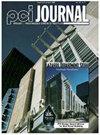Flexural behavior of full-scale, carbon-fiber-reinforced polymer prestressed concrete beams
IF 0.9
4区 工程技术
Q4 CONSTRUCTION & BUILDING TECHNOLOGY
引用次数: 0
Abstract
Highway bridge beams are subjected to aggressive environments, temperature fluctuations, and millions of loading cycles throughout their service life. The combination of these effects can result in the reduction of the service life of structural components. In the past decades, more-durable composite materials, such as carbon-fiber-reinforced polymers (CFRPs) have been implemented in concrete structures to address problems related to environmental durability. To date, prestressing applications of CFRP in beams have been mostly investigated for rectangular cross sections, which are not representative of the geometry used in modern highway bridges. In addition, the construction and detailing aspects of CFRP prestressed concrete beams have not been investigated outside of laboratory conditions. This paper describes an experimental investigation conducted on eight 40 ft (12 m) long AASHTO Type I prestressed concrete beams with 3 ft (0.9 m) wide composite concrete decks and detailed identically to highway bridge beams in practice. Three beams were pretensioned with carbon-fiber-composite cables, four beams with CFRP bars, and one with prestressing steel. The beams were tested under monotonic and fatigue loading. All CFRP prestressed concrete beams were designed to fail due to the rupture of the prestressing CFRP. The CFRP prestressed concrete beams exhibit several desirable features of the typical steel prestressed concrete beams in terms of serviceability and strength.全尺寸碳纤维增强聚合物预应力混凝土梁的弯曲性能
公路桥梁横梁在其使用寿命期间受到恶劣环境,温度波动和数百万次加载循环的影响。这些影响的结合会导致结构部件使用寿命的减少。在过去的几十年里,更耐用的复合材料,如碳纤维增强聚合物(CFRPs)已被应用于混凝土结构中,以解决与环境耐久性相关的问题。迄今为止,CFRP在梁中的预应力应用主要是针对矩形截面进行的研究,这并不代表现代公路桥梁中使用的几何形状。此外,CFRP预应力混凝土梁的施工和细节方面尚未在实验室条件外进行研究。本文描述了对8根40英尺(12米)长AASHTO I型预应力混凝土梁与3英尺(0.9米)宽的复合混凝土桥面进行的试验研究,并与实际公路桥梁梁的细节相同。其中3根梁采用碳纤维复合索,4根梁采用碳纤维布筋,1根梁采用预应力钢。对梁进行了单调加载和疲劳加载试验。所有CFRP预应力混凝土梁都被设计为由于预应力CFRP的破裂而失效。碳纤维布预应力混凝土梁在使用性能和强度方面表现出典型钢预应力混凝土梁的几个理想特征。
本文章由计算机程序翻译,如有差异,请以英文原文为准。
求助全文
约1分钟内获得全文
求助全文

 求助内容:
求助内容: 应助结果提醒方式:
应助结果提醒方式:


